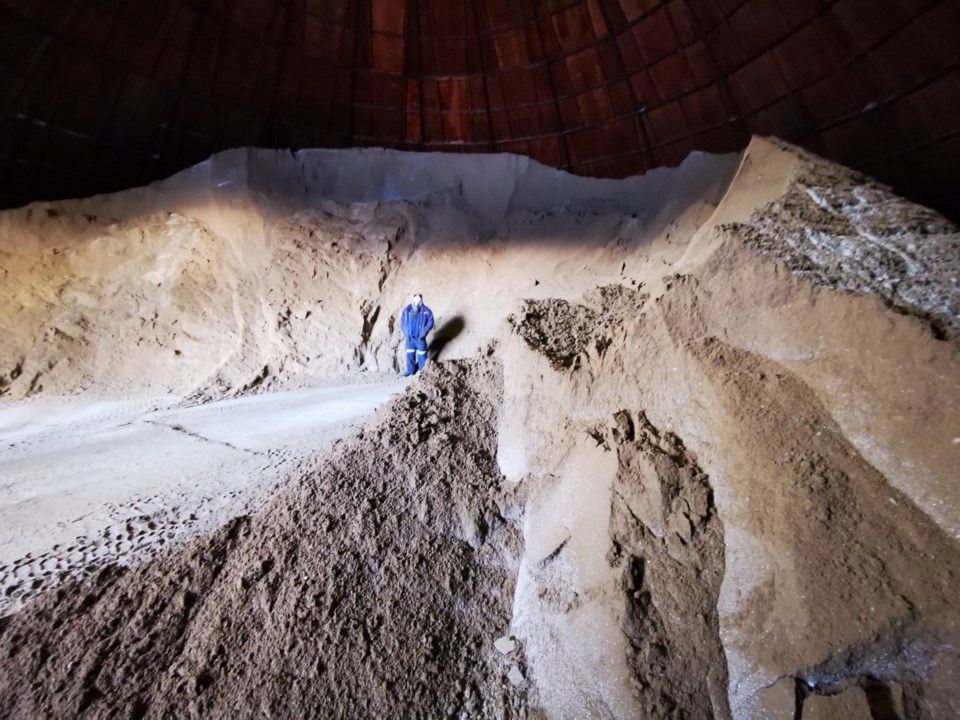Townships track road salt, sand like gold using modern technology - Orillia News (orilliamatters.com)
Every autumn, Ontario municipalities prepare for winter’s onslaught by buying up thousands of tonnes of sand and salt that will eventually be used to keep roadways and highways clear and free of treacherous ice.
This winter, Oro-Medonte, Essa and Springwater townships will spend about three quarters of a million dollars, combined, on sand and salt.
They track it as if it were gold.
Using modern technology, virtually every ounce of material can be tracked and the efficiency of the sand and salt program can be evaluated at almost any time. Plows are equipped with either a global positioning system (GPS) or an automated vehicle location (AVL) system and electronically controlled spreaders.
“We use computerized spreader control, which allows us to manage how much material we are putting down and where we are placing it,” said Shawn Binns, director of operations and community services for Oro-Medonte Township. “This helps with ensuring optimum application while meeting our maintenance requirements to ensure the safety of the travelling public.”
 Scott Thomson, an operations department employee with Oro-Medonte Township, surveys the stockpile of sand in the township's material storage dome in Moonstone. Wayne Doyle/BarrieToday
Scott Thomson, an operations department employee with Oro-Medonte Township, surveys the stockpile of sand in the township's material storage dome in Moonstone. Wayne Doyle/BarrieToday
According to Ontario’s Ministry of Transportation, salt spreading helps to melt snow and ice to prevent it from sticking to the highway and makes plowing more effective.
Sand provides traction on slippery surfaces, especially when it is too cold for salt to be effective, below minus-10 degrees Celsius.
Salt, an accepted mainstay of road maintenance today, wasn’t used in winter maintenance in Canada until the 1940s.
Prior to that, sand and small gravel was used to increase traction on snow-covered roads.
How much salt a municipality uses varies.
Springwater Township uses a six per cent salt content mixture, according to Scott Haw, manager of roads and fleet, infrastructure and operational services.
“The township purchased 5,000 tonnes of sand and 300 tonnes of salt which are mixed together in a process called brining,” Haw said.
Binns says Oro-Medonte uses a mixture that is seven per cent salt content.
Prior to 2023, Essa Township used a four per cent salt content mixture, but upped the salt content to 10 per cent last year.
Essa is considering increasing the salt content to 15 per cent in 2025.
“We’re looking at gradual increases similar to what larger municipalities are doing,” said Michael Mikael, manager of public works/deputy chief administrative officer for Essa Township.
According to Binns, a typical winter season in Oro-Medonte features about 60 'snow events' that require attention.
Those events may be post-storm clean-up or preemptive storm maintenance.
He said that’s the rolling average of the last five years and it’s up from the five year average before that.
“There’s definitely been less snow, but our main issue has been the temperature,” Binns said. “We’ve been experiencing an increase in freeze-and-thaw cycles and that’s driving our material usage.”
Haw hasn’t had the same experience. He says sand and salt use in Springwater is down so far this year.
“If temperatures had been closer to freezing at the end of December, we would have been out more due to freeze-thaw cycles,” Haw said. “However, since temperatures are forecasted to be lower in January, we anticipate our sand and salt usage will increase.